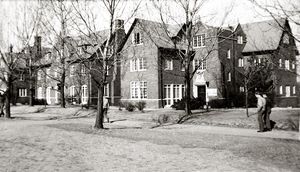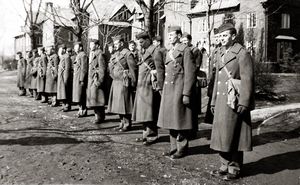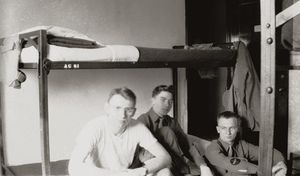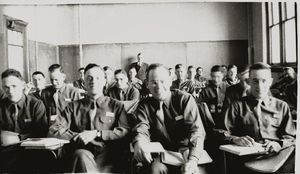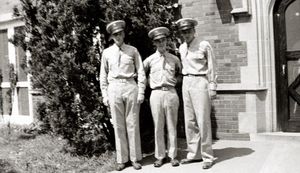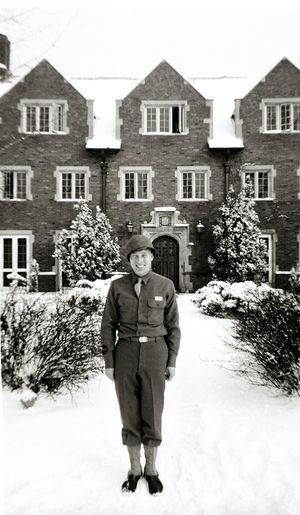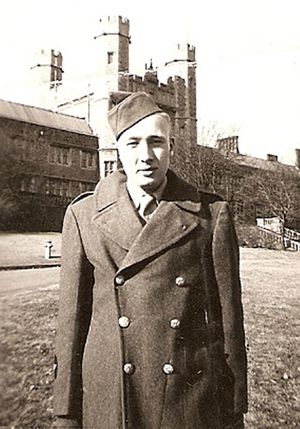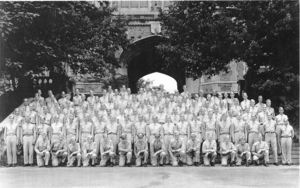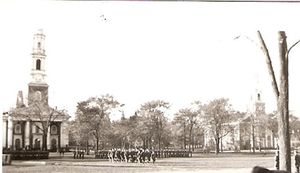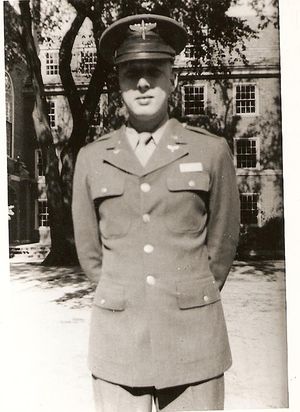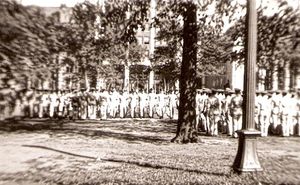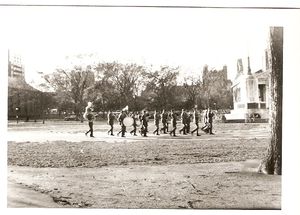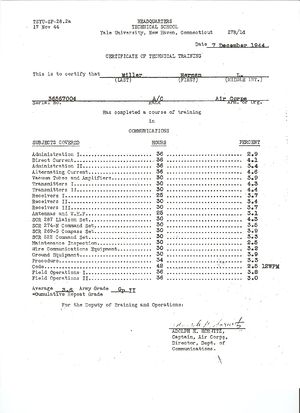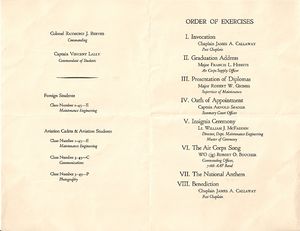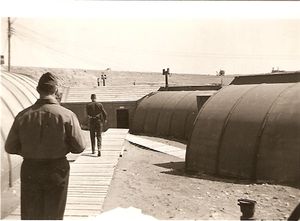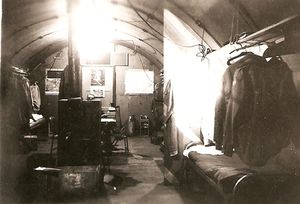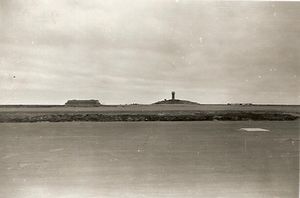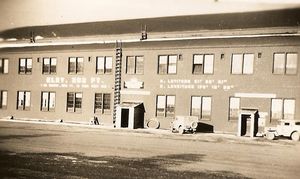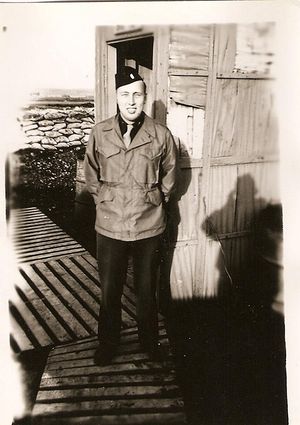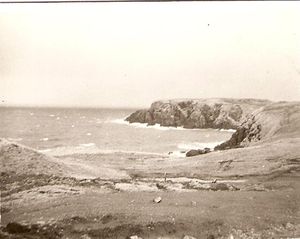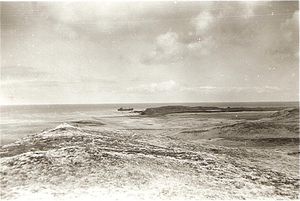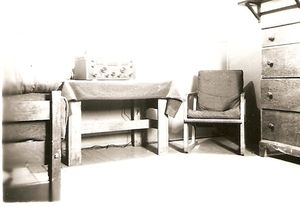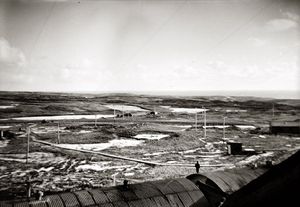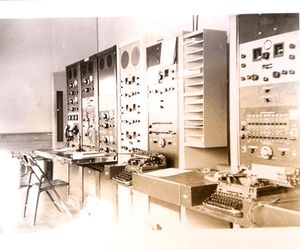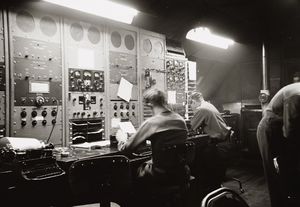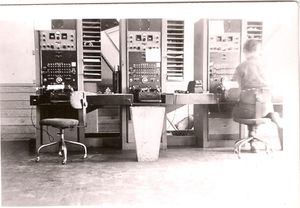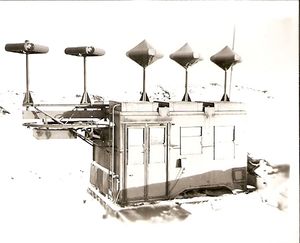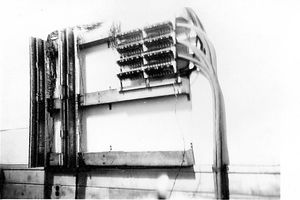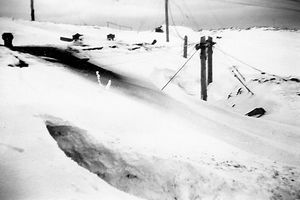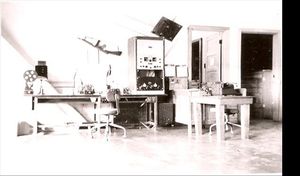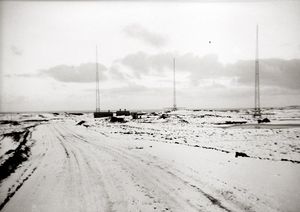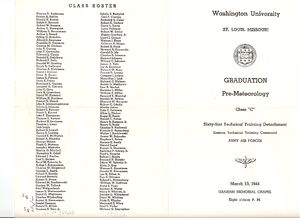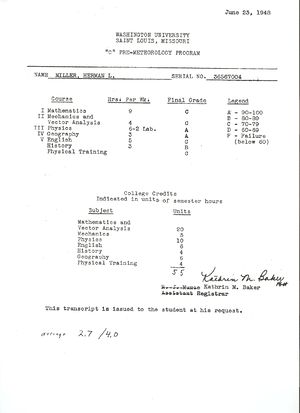First-Hand:My Experience in the Army Air Force, 1943 to 1946
My Experience in the Army Air Force, 1943 to 1946
By Herman Lunden Miller, July 15, 2010
Into the Army
My army experience might seem trivial in comparison to that of a man who joined the Marines and landed under fire on two or three islands, but it was very challenging during a formative period of my life. I went through an arduous training program for a demanding job. Incidentally, it shows how the Army Air Force met its need for officers to operate and maintain its radar and advanced communications equipment at a time when such men had been drafted out of colleges. It started me on a lifetime career in physics, including radiation safety, controlled thermonuclear research, the space program, and nuclear power plants.
This report is organized by time sequence. My memory was aided by having kept the orders that sent me most places, photographs, graduation roster, and other mementos.
When I startedengineering studies at the University of Michigan in September 1942, every man was looking for the best thing to get into in the armed forces. Draft boards were taking college students at the end of any semester, no longer waiting for them to finish a degree or even a school year. The navy was offering the best deals, but most requiredtwo years of college to get into them. The next best was the Army Air Corps' Pre-meteorology-C program, for which I could qualify. It consisted of a twelve-month course at one of several prestigious colleges, consisting of two simultaneous mathematics courses, finishing with integral calculus, mechanics and vector calculus, plus physics, geography, English, and American history. This was to be followed by several months of actual meteorology training, (which might be at U. of Michigan) then a commission as second lieutenant. Probably, there were only about three thousand men in the program, spread over eight or ten colleges.
Applying for the program went well except that my parents had to sign an aviation cadet application, which my mother did not want to do. Fortunately, they were in Oregon then, so my father had to persuade her to sign. I had to submit transcripts and letters from my instructors, then I had an interview with a member of the University Meteorology Committee. He wrote on his report that on the Iowa Achievement test I was at the 99th percentile for Science and 93d percentile for mathematics. He seemed impressed with my ruggedness and my father's having kept his army commission from World War I. Next, I had to make a train trip to Gaylord to have the draft board transfer me to Ann Arbor, and draft me on just the right day to finish the semester, and make connections everywhere. It was eleven weeks before my nineteenth birthday.
Very early on the morning of February 3, I went to the Ann Arbor draft board office and met six or eight other students going into the program. All of us were concerned that the Army would foul-up and send us to the wrong place. We took the train to Detroit, then a streetcar east on Jefferson to the Induction Station in a big, old building. We all passed the physical exam, then were told to catch the train at about eleven that night to Fort Custer near Battle Creek. There was a carload of us going to Fort Custer, so the railroad pulled the car there from Battle Creek. After about an hour's sleep, we went to breakfast, then clothing issue, then intelligence testing, which we did not do very well because we were tired. We sent our civilian clothing home, but I kept my log-log decitrig slide rule and book of Mathematical Tables from the Handbook of Physics and Chemistry that I would need.
We were issued all the clothing we would need, from shoes to helmet liners. Helmet liners were made of plastic and fiber and were vastly superior to the tin hats of WW I in having webbing with space between the hat and ones’ head. There was both protection from being hit on the head, and from the heat of the sun. Steel helmets could be attached to helmet liners, but we were never issued any. We received olive drab wool knit caps that were good for outdoor work in winter and could be worn under a helmet liner–and after the war under a hard hat.
We were issued "dog tags" that had our name, army serial number, religion, and name and address of next of kin stamped into them. Dog tags were made on the same machines used to make plates to print address labels for periodicals. Tags were of brass and corroded, so we had to polish them for every inspection. That chore ended during the summer of 1943 when the army replaced them with aluminum. At first, we wore them on a string around our neck, but the strings got dirty quickly, so we tried silver chains, then there were clear plastic strings that worked well.Finally, there were stainless steel bead chains, which are still standard..
At the same time I was going to Fort Custer, my father was transferred from Pendelton to Reno Army Air Base, so my parents and I worried about losing track of each other.
This was about the time of peak numbers going into the army, so the reception center was overcrowded and I slept in a big converted garage, which was warm enough, but lacked enough plumbing for the large number of men there. After a week of this we loaded everything into our barracks bags and in the morning before breakfast, we caught the Grand Trunk train in Battle Creek, (breakfasted in the diner), to Chicago. There we changed to the Wabash for St. Louis and Jefferson Barracks on the river at the south end of St. Louis.
When we got to the Jefferson Barracks hutment area, the men there yelled "You-all ain't gonna like it here" and we surely didn't. We had drill on the parade ground, lectures or training films indoors during bad weather, a day on the rifle range, and a day each of chemical warfare defense, and camouflage training. Hutments were colder and draftier than the huts the Revolutionary army had at Valley Forge and Morristown. (Whenever Japanese internees complain about their housing, one should remember the US Army did worse by its own.)The only heat was from a tiny, ineffective coal stove we could fire up when we got back from dinner. I was not awarehow fast the weather would change from warm to cold in that area during February, so I developed colds twice, called atypical pneumonia, with pus coming out my eyes. The affliction put me in the hospital and kept me from shipping out when I would have gone to U. of Chicago. Eventually, in mid March, I got through Air Corps basic training. We went in a convoy of 2-1/2 ton trucks with a police motorcycle escort to Washington University at the western edge of St. Louis.Other men came from Atlantic City where they had their basic training at hotels the Army had taken over.
Washington University, St. Louis, Missouri
Washington University was a good place to be. Its first buildings had been built for, and used by, the World's Fair in 1904, so the campus was mostly Tudor Gothic architecture. We lived on campus in a row of large houses that had been occupied by fraternities. The most easterly house was equipped and staffed as a dispensary. Our teeth were repaired at the Dental School, a street- car ride away. Detachment headquarterswas in the second house from the east where the nine noncommissioned officers, including the first sergeant, supply sergeant, drill sergeant, detachment clerk, and truck driver slept. At first, we were crowded in without furniture, except as many double deck bunks as possible, in every room except the basements. As men washed out, we had more space, and a PXwas set-up in the living room of the former Sigma Chi house.
After wake-up call in the morning, we had five minutes to dress, then fell into our regular formation for reveille. Then at timed intervals, each flight marched off to breakfast. We ate at the mess hall of the men's dormitory, which was occupied by an air crew training detachment getting college classes type pre-preflight training. The Premeteorology-C detachment was organized into two squadrons of three platoons, or flights each. Flights started with about forty men, but dwindled to about twenty-three, who were together from reveille until after dinner, all year. They were led by student officers. We marched to class (and everywhere else we went) in column of threes formation, crowding the civilians off the walks. Still, we did an hour of close order drill every day to keep in practice. We had a Jewish drill sergeant who liked to make up meaningless words that sounded funny. Usually we sang marching songs like Sixpence or ad-libbed "Who the hell are we? We're the meteorologists who make the prophecy" or “They say this is a mechanized war, so what are we marching for?” or our own words to the Volga Boatmen song when we felt mistreated. We were issued textbooks, then heavy canvas over-the-shoulder bags to carry them. This kept up a military appearance when we marched to and from class, and the bags were great for carrying clothes on furloughs. There was an hour of physical training every day, so I had a chance to swim in a pool and to play basketball.
We just went to class the rest of the day and studied during the evenings, except that the physics labs were in the evening once a week. My lab partner felt he should not have to work in the evenings, so he washed out after three months. Some washed out because they could not stand the stress. One washout said he just wanted to wash airplanes. We had two mathematics class series running simultaneously. One series started with a review of college algebra, then went into analytic geometry, then differential calculus, then integral calculus. The other series began with trigonometry, then went into vector analysis, then vector calculus, then finished with mechanics. We had a geography course as background for meteorology. Saturday mornings we had classes. In the early afternoon we had a “GI party” to clean up our barracks, followed by inspection, then we were off duty until Sunday night. The sergeants insisted on our wet mopping the varnished wood floors, soon removing the varnish. We lacked the usual dust mops or vacuum cleaners. We did not do guard duty or walk tours for punishment because the emphasis was on academics. My three roommates came from New York City, small cities in Minnesota and southern Illinois, and were quite representative of the Detachment's nationwide diversity overall. I learned to recognize the accents of the various New York City boroughs. We could recognize other pre-meteorologists by their shirt pockets stained with ink from leaky fountain pens.
One day of the year each of us was "charge of quarters" (CQ) spending the evening in detachment headquarters with a list of names and numbers to call if something went wrong. The CQ was given an alarm clock to awaken him; then he had to wakethe detachment. The CQ could expect to find his bed springs unfastened and his bed propped up so it would collapse under his weight. I had a small pair of pliers in my barracks bag so I could quickly fix my bed springs and go to sleep.
Early in May, I finally got over my cold and could smell things again. I found I liked St. Louis. Wecould go anywhere by streetcar or bus. The University streetcar line ran along the north side of the campus and went all the way downtown with cars that were newer and nicer than in Detroit. There were very old buildings along the river that were strange to me because Detroit had lost most of its old buildings. There were river boat cruises on the Mississippi, the summer light opera in Forest Park, a big USO downtown, the Kiel Auditorium, and there were girls on campus. There was a little shopping center with a dry cleaner, drug store, and grocery store north of the northwest corner of campus.
In late spring, there was a period when it was normal to rain every afternoon. When that period ended, the temperature went into the nineties with high humidity. We had to adapt to the heat in classes, studying, and sleeping. In fall, the weather was almost perfect with moderate temperatures and no rain.
During summer, we wore cotton khaki uniforms with long sleeves and neckties all the time, but had only been issued two uniforms, which were not enough with laundry sent out once a week. We tried wearing the army fatigue uniform for a week, but it was heavy, stiff, herringbone twill, and convinced everyone it was more uncomfortable than the khaki uniform. I bought five sets of khakis. They had epaulets, which I had to remove, but saved them, so when I was close to finishing at Yale, a group of helpful ladies sewed them on again. If a man had no loose epaulets, they made them from his shirt tail. We wore meteorology patches on lower right sleeves until we finished at Washington University.
When we first had officer type physical exams, 23 men washed out; some because they had developed high blood pressure. This must have been caused by stress, since they were only 19 to 20 years old.
In June, we had our first nationwide exams prepared at the University of Chicago. I was fortunate in getting the top score in Geography, of all things, but several men washed out. After that, we all got a one week furlough and food ration coupons. My father had timed his leave with mine, so he and Mother drove from Reno to St. Louis, picked me up and drove north to the Farm in Michigan. Mother stayed at the Farm with the car until fall, then drove alone to Reno. Dad and I went by train back to our duty stations. From the Wabash train, going by what is now Detroit Metro Airport, I saw a B-19 experimental plane that was larger than a B-29.
The Meteorology Committee at University of Chicago planned our academic program and prepared the quarterly national examinations. The national exams had a great effect on our instructors. Their attitude changed from the usual college instructor's indifference to whether anyone learned anything or not, to really trying to prepare men for the exams. It was a pleasant experience!The instructors were employed by Wash U and the lecturers were senior faculty. I think the textbooks were the same as used by Wash U. I did buy, and still have, the very comprehensive general physics text by Chicago University Professors Lemon and Ference with illustrations of experiments.
In September, there was another national exam preceded by rumors of cheating plans. For the exam, we filed into a big lecture room and took seats. Every second man was told to go to a different room and take seats so no one was right next to anyone else. More men washed out, and we got a week's furlough. If men had been allowed to cheat, the wrong ones would have washed out.
I caught an early evening train to Denver, and breakfasted while riding in sight of the Front Range of the Rockies. I had a few hours in Denver to see the Museum of Natural History, then went out on the Rio Grande RR and across the Rockies through Moffat Tunnel.About thirty hours later I arrived in Reno. Mother drove me to all the sights around:Virginia City, Carson City, etc. Dad showed me around the Reno Army Air Base.
When we got back to Wash U, we learned that the Air Corps had decided they did not need a meteorologist with every squadron as they had thought, so they would not need us. Perhaps, someone had thought very bright young men should be kept out of harm's way. Graduates of the Pre-meteorology-B program who had just finished that program did go on with meteorology training.The army treated us very well, giving a choice of going into a communications cadet program, flying cadets, or enlisted weather observer training. I was happy to go into the communications cadet program because of my long interest in radio. Most of us stayed on at Wash U. until we finished the program, which was excellent background for any of the physical sciences or engineering. Fortunately, there were only about three thousand men involved in the whole Premeteorology-C program, so we did not attract attention like the large Army Specialized Training Program, which ended suddenly with most being sent to ground forces as replacements for combat losses. When we marched off to class one morning in March, we saw the unhappy ASTP group waiting to leave. The ASTP students, who took courses in engineering and physical sciences, lived in the women's dormitory.
Christmas week of 1943, I spent with my parents in Reno having an exceptionally good time with dates. I had to get on the train very early Christmas morning, and spent the day riding across Nevada, Utah, (and Great Salt Lake on a low trestle), arriving late the next day in St. Louis with classes starting the next morning. During our last class, our physics professor suggested that we major in physics after the war because we had a good background. Later, I did get BSE and MS degrees in physics at U. of Michigan. After the war, seven of the men who were at Wash U. Premeteorology were at the U. of Michigan, which gave 48 semester credit hours for the Premeteorology-C course, the equivalent of three full-time semesters. One of the men was a graduate student in Psychology.
We finished March 11, 1944 and had a simple graduation ceremony in the chapel that had been copied from Kings College at Cambridge. Then we met our faculty socially at a reception. One graduate married his hometown girl in the chapel. We had a great dinner dance with our girl friends at Normandy Hills country club, and a grand send-off to a challenging time. There were no furloughs, so the next day we got on trains to our new destinations. The Technical Training Command had somehow planned this so there were the right number of spaces for the men at each place. The Command was headed by alumni of Texas Agricultural and Mechanical College, a very militaristic college at that time.
The 136 graduates were distributed as follows:69 to Aviation Cadet Pre-Technical School at Seymour Johnson Field in North Carolina.(Only about three of the 69 washed out there or later at Yale.) About another 36 became flying cadets for navigator training and most graduated. About 31 went to enlisted weather observer school, and then to a radar school at Harvard. (Mostcompleted their course.) This totaled about half the men who had started twelve months before.
Aviation Cadet Pre-Technical School
The Pre-tech course was three months long, and similar to Officer Candidate School, with courses such as military law, management, public speaking.There was a week of guard duty, lots of close order drill and stressors to eliminate unstable and neurotic men. The study material was not as difficult as we were accustomed to, but there was a lot of it, and it came fast. There were no study dates in the library!Some of the students had been enlisted men in the fields they would study, and some had been in the enlisted reserve with relevant education or experience. Cadet officers and cadet sergeants ran things on a daily basis, but were supervised distantly by real first or second lieutenants called "tactical officers" for each squadron. Never again were we given orders by sergeants or corporals. Cadet officers were called "bottlecaps" because their insignia of rank was the shape and size of bottle caps. When marching, they would say, "Look proud, you're cadets now."They converted us to "on the ball, eager beavers" in a hurry. An overzealous bottlecap told me this was a military installation so I should not take photographs. So I have no photos of Pre-Tech School, except a big panoramic photo of squadrons A through K in line at Seymour Johnson Field that I bought. We had been invited to try-out for cadet officer positions soon after we arrived. We could try out for the close order drill team that did fancy drill that had originated in the reign of Queen Anne.
Soon after arriving we were given large white pills to prevent our getting influenza. None of us did, but it was springtime. We were issued aviation cadet service caps that had a blue band, and a wings and propellor insignia in front. We changed to officer type US, wings and propellor insignia on our collars or blouse lapels and flight caps. Our pay increased from $50 to $75 per month. When we had guard duty, we had to memorize the General 0rders for sentries. I was walking "my post in a military manner" with my gun at right shoulder arms when the sergeant of the guard sneaked up behind me and pulled the gun out of my hands. I had failed to "observe everything within sight or hearing" as the general order requires. but the embarrassing experience got me on the ball. Dish washing there was unusually rough and ready. We filed out of the mess hall carrying the usual dished stainless steel trays to a garbage can where we scraped off leftovers. Then we dipped our trays into a big galvanized can of hot soapy water, then into a can of hot rinse water, then a second can of rinse water, then stacked them. We had calisthenics and "grass drill" (exercises while lying on the ground) so that we were sweaty and very dirty. Then there were just five minutes to change to class A uniform for inspection and retreat, with no time for a shower. We had a new marching song to the tune of Interlochen: “How we hail you, how we praise you, good old Squadron G, etc.”We also sang a folk song about the Titanic sinking. We did not sing the cadet words to the Whiffenpoof song.
Halfway through our program, the school was moved to San Antonio Aviation Cadet Center (SAACC), as was the Officer Candidate School from Miami. We got there after a long rambling trip in a troop train. Train routes were selected to save money because the government got lower rates by going over land grant railroad.Most military travel was by train, which placed a big burden on the railroads. They habitually ran late west of Chicago, but usually were on time in the Northeast. West of Chicago, railroads had older Pullman cars called “tourist sleepers” that sold at a lower rate and were often used for troops.Fortunately, I never had to travel in one of the troop sleeping cars that really crowded the men, with bunks close together and three levels high. There would not have been enough cars without these. They had plaques saying they were owned by the government's Defense Plant Agency. Meals were prepared by a crew that apparently spent its army career on troop trains, cooking on coal stoves in railroad baggage cars, where the chow line was located. I can't remember how our trays were washed. Ladies (Mothers of Men in Service) the age of our mothers, had cookies for us when the train stopped at stations. The relocation was made to use premium facilities that were under-utilized because of cutbacks in training flying cadets. Cadets who originally had been in the ground forces had just been arbitrarily eliminated from that program and sent back to the ground forces. Facilities were better than anywhere else I was in the army. We had swimming pools at SAACC, but not at other army bases. We had choices of deserts and vegetables, meals cost $1.40 per day. There were so many soldiers stationed around San Antonio that it would be overloaded on weekends, so our school could only go to town on Thursdays.
In only one day, we learned to shoot the .45 caliber semiautomatic pistol, the Thompson submachine gun, and the M-1 carbine. We were shown, and told about the M-2 carbine and the "grease gun" submachine gun. We did not even see an M-1 Garand rifle.
I had trouble with loose cartilage in my right knee, spent two weeks in the hospital; noticed that operations on knees did not turn out well. Gradually, my knee loosened without surgery. When I got back to duty, I was no longer with my friends from Wash U, but in the next to last class to go through, so if I got sick for more than one week, I thought I was out! I still had trouble with my knee, and the doctor said if I complained further, I would be eliminated from the program, so the tactical officer made me the squadron clerk, and I avoided some physical activities. At Yale, I passed a test stepping up onto a one foot high stool and down every two seconds for four minutes.
Technical School, Yale University
July 14, 1944, our squadron of 157 men got on Pullman cars for the trip to Yale University, Aviation Cadet Technical School. Some were for communications training, others for armament, photogrammetry, or aircraft maintenance engineering, to meet the need for officers well grounded in technical subjects. Some of the cadets had been working as radio mechanics or operators, or teaching at enlisted schools in these specialties. At Yale we had to get used to being underclassmen again with upperclassmen asking questions like "What are you here for, mister?" the correct answer was:"Sir, I am here for discipline, discipline, and more discipline." (Army Officers must be self-disciplined so they can be relied upon to obey higher authorities.) (Cadets were spoken to as "mister.")Some other questions were calculated to make one lose one's temper. "Hit a brace, Mister"; a brace is an exaggerated position of attention,good for developing military bearing. There was great emphasis on the honor code and honesty, any breach of which caused washout. It really did make us "on the ball, eager beavers.”Cadets who washed out academically went before a board of officers, then were sent to aerial gunnery school at Tyndall Field and became replacements for combat losses. When Lieutenant Colonel Wise, commanding the school, spoke to the group, he stood at parade rest used no gestures, but had an expressive voice and used emphasis well.
The school had no connection with Yale University, except that we used their buildings. Our dispensary was in a colonial vintage building in the center of the Old Quadrangle. Sick call was run by an enlisted man while the Medical Officer sat and read a magazine.Some instructors were in the army and some were in civil service. Physical training instructors were Yale staff members with sadistic tendencies. "Supine Charlie" was infamous. Cadet classes were just one week apart and had a different instructor and topic each week. Each week ended with both a written test and demonstrating one's ability to use and maintain the equipment. I would do very well on the written test, but had difficulty impressing the instructors on interview tests and was graded down. The first half of the course was on electrical theory taught without calculus or imaginary numbers, but still effective in giving a grasp of the subject. Our high powered math was not used. We assembled simple circuits with "snap leads" that went together and came apart easily for use many times. During the week on transmitter theory, we all had to assemble and solder wires of a radio transmitter from a kit that many previous cadets had assembled and disassembled. If one could assemble the kit so the wiring appeared neat, and the transmitter worked, one got a perfect grade, but this almost never happened, so one's grade was never perfect.Even if one had experience, and the transmitter worked, but did not appear neat, one's grade suffered. (My situation)I was inclined to help other students without realizing that helping them hurt me. After the war, the University of Michigan gave people eight semester credit hours for the program.
The second half was meant to be very practical, dealing with specific radio equipment (I never dealt with again, except for the BC-221frequency meter) used in airplanes or to communicate with them. SCR stood for Signal Corps Radio, BC stood for Basic Component. Some used small electric motor-generators to convert the 24 to 28 volt DC power from the airplane to the 250 or 300 volts needed for vacuum tube plates. Newer equipment used 120 volt, 400 Hz power from the aircraft's central supply with transformers instead of motor generators.
We learned to use and tune or set-up frequencies on the:
- SCR-269G radio compass (airborne direction finder);
- 274N set of medium range, high frequency radio transmitters and receivers used to contact control towers, radio ranges and direction finder stations;
- SCR-522 VHF transmitter-receiver used to contact control towers and VHF direction finder stations. It had 4 channels controlled by the pilot. At 45 second intervals it switched to the fourth channel automatically and transmitted a tone signal so direction finders could locate the airplane.
- BC-348 long range communications receiver used in airplanes;
- SCR-287 long range, old, variable-frequency-oscillator, power-amplifier transmitter;
- AN-ART-13 long range transmitter used in newer bombers. It had 32 crystal controlled channels that could be selected from the cockpit, and had a pi output circuit to load into any antenna.
- SCR-?? Long range, truck transportable transmitter used on the ground.
We learned the system of the Army's regulations, field manuals, technical manuals and (aircraft) technical orders. There was a cursory glance at radar fundamentals, so we learned the difference between an A-scan and the new, sophisticated, plan position indicator screens. We were not taught the logic and technique for locating the trouble when equipment fails, though these would have been very useful. We practiced Morse Code until able to pass a test at twelve words per minute. There was a week of guard duty armed with a loaded .45 caliber pistol. The last week of November and first week of December we practiced maintenance of electronic equipment in dilapidated airplanes at New Haven Airport. It was so cold I wore every bit of clothing I could put on, andhoped I could finish before I developed pneumonia.
There were three shifts. My shift got up about 0430, marched to the Yale Commons (mess hall) to eat breakfast, then cleaned our rooms for inspection. We were in class from 0600 to noon and learned techniques for staying awake, like washing one's face with cold water. After lunch, we had two hours of physical training in the well-equipped, fourteen story Payne Whitney Gymnasium, where I managed to pass everything, such as sit-ups and staying afloat in the deep pool for 45 minutes. If a man had a cold, he could sit in the steam room instead of active exercise. Then we went back to the Old Quadrangle and got ready to stand retreat in class A uniform. At 1600, the moment the clock bell stopped ringing, we heard "Group, Attench-hut!" then "Squa-dron, Attench-hut!"Then the command was given to march out in column of threes through the arch and across the street to the New Haven Green, where we formed in squadron fronts for retreat (lowering the flag ceremony.)
The band marched out of the quadrangle behind us playing march arrangements by Glen Miller, who had been their commander until he went overseas. A big crowd of people stood all around the Green watching us. When we were all lined up, the cadet adjutant read the orders of the day in traditional sing-song voice:"Attention to orders, orders of the day, Officer of the day: Aviation Cadet Whoomff, By order of Lieutenant Colonel Wise."
There was a lot of tradition emphasized.After retreat, we “passed in review,” then marched off to dinner. Once, when we got to the mess hall, the Tactical Officer had us keep standing at attention in formation until someone moved. The Tac seemed to be watching me, especially when he walked toward me, but he stopped by the man behind me and told him to walk two tours (punishment). After dinner we marched back to the quadrangle and studied until lights out at 2120 (9:20PM). Another shift had class from 1200 to 1800, so they could only do retreat on Sundays. The third shift had class from 1800 to midnight, and their hours were so different from the rest of us that they slept at Stillman College. On Sunday nights, just outside the arch of the quadrangle, there were long, loving good nights between cadets and their wives.
I lived in a three-room suite with five other cadets. Two rooms fronted on the New Haven Green where all the streetcars in town made noise going around most of the night. The other room fronted on the courtyard where the guard assembled,changed every four hours and unloaded their pistols, occasionally discharging one. The activity made it hard to sleep. Clothing was stored in dresser drawers, but they had to be left open for inspection with socks rolled and clothing folded neatly. The drawers became just for display, and we lived out of our barracks bags. All our marching and formations killed the grass in the quadrangle.
We had two weekends when we could go as far as 200 miles from Yale. On one, I went to New York City and on the other I went to Harvard and saw the men from Washington U. who had gone into weather observing school and then on to radar training at Harvard. On one ordinary Sunday, I visited a high school classmate at the New London Submarine Base. (Our mothers had a network keeping track of where friends and relatives were.)One Sunday another cadet and I rented bicycles and explored New Haven.I saw a play at the famous Taft theater.
I graduated and was commissioned December 7, 1944, just three years after Pearl Harbor. Seventy-eight others were commissioned as communications officers then, but there is no information about the other specialties. H. L. Miller in Old Yale Quadrangle We were not allowed to have guests atgraduation because of wartime transportation limits. Several weeks before graduation we were told to order officer's uniforms at any of several suppliers. We received a clothing allowance on graduation day,paid suppliers for our new uniforms, then stood inspection to be sure they fitted properly.Officers' winter uniform coats were of a heavy woolen weave called Elastique that would stretch somewhat, and seemed to wear forever. We each bought a footlocker and B-4 bag at the post exchange. B-4 bags were made of strong fabric, and could be hung up with an unfolded uniform inside, but folded for carrying easily.When we turned in our enlisted uniforms, many of us kept the big wings and propeller insignia that we had worn on the front of our hat as a souvenir of an intense experience. After a very full day, we got on trains for home, but I was late for a date with a hometown girl in New York. Classes began and ended on Thursdays, so we were not traveling on weekends when trains were overcrowded.The School was moved to Chanute Field, Illinois, and thenceforth the students were commissioned officers being retrained, but a few were leftover cadets.
Going through cadet training was like being ground in a big machine for eight months, and finally coming out a second lieutenant.
Along with several other graduates, I was ordered to an Army Airways Communication System (AACS) Group headquartered in Kansas City instead of the radar school I wanted to go to. We had ten days"delay en route at the convenience of the government," since we had lost the leave accumulated during the previous 11 months, but deserved some. I visited Dad in Detroit where he was working for the Ordnance District; then Mother at the Farm, where I went skiing, and heard about one of my schoolmates being killed in France. I put a two-tube regenerative radio receiver I had made earlier into a small box I could take with me. My colleagues were not impressed with it. I visited the girl friend in St. Louis en route.
Duty Stations, Army Airways Communication System
Several of us brand-new second lieutenants were sent to Midland Army Air Base, where bombardiers were being trained, ten miles west of Midland, Texas. This was a good place for us to get experience because the base had most of the radio facilities an overseas base would have, unlike most in the continental U.S. We had not learned about this equipment at Yale. We did six hour shifts in the control tower and in the ground-to-air radio room. There were so many flying accidents that every morning I looked to see if the flag was at half mast. The control tower had to deal with traffic problems from a long line of AT-11s waiting to take off on training flights in the mornings, then all wanting to land about the same time in the afternoon. There was a separate call sign (JL-36) and tower frequency for dealing with the training flights. At night, nothing was going on, except an Air Transport Command cargo plane stopped en route to deliver airplane parts. Four of us rearranged our shifts for more time off and visited Carlsbad Caverns. My cousin, Marjorie Cram, was at Midland with her husband, a bombardier being retrained tonavigate also, after completing his missions in Europe.
January 31, 1945, we along with many others, were ordered to Sheppard Field, near Wichita Falls, Texas to attend an AACS officer orientation course that lasted a month. We had lectures from a lieutenant colonel who gave us a much better knowledge of AACS, which operates and maintains control towers, ground-to-air radio stations for position reports, radio range stations, direction finders, and stations for handling weather data, messages to and from flying generals, and point-to-point: flight plans and airplane position reports. AACS operated communication and navigational aids on all the routes American airplanes needed to fly. After the war, these became the routes of civil aviation. Pilots had to be able to contact groundradio stations to get weather information and to send their position reports.AACS History is fully described at web site: www.ibiblio.org/hyperwar/AAF/VII/AAF-VII-12.html.
From this site:
At the close of WW II, AACS operated more than 700 stations located in more than 100 countries, serving more than 100,000 miles of airways. To man these installations and assure their necessary co-ordination, AACS had a roster of 4500 officers and enlisted personnel to a number exceeding 45,000.
The world was divided into eight AACS Wings for administration from Asheville, North Carolina, so we had a chain of command outside the base where we were. Some people took improper advantage of that, trying to be independent of the rest of the Army. (After the war ended, the Army commanding officer on Umnak said he was going to get AACS back in the Air Corps, and the Air Corps back in the Army.)We got a world view and learned that the China-Burma-India theater was the worst place to be.AACS detachments did not have a Table of Organization and Equipment like most army units, because they had different type equipment to operate at each base. Higher headquarters generated a manning table for each detachment almost monthly, and the Army had a regular Table of Allowances that stated what equipment, such as trucks, was required for each type of station.
After orientation, we had a choice of either going to a school at Seymour Johnson Field for automated handling of weather data or cryptographic officer school at Chanute Field. I could not find out enough about the school at Seymour Johnson Field to know that it was the better choice, so on the basis of location, I chose Chanute, some distance south of Chicago. While there, I had the experience of flying in a B-25 into what is now Detroit Metro Airport when it was an Army Air Base with German POWs working and driving a jeep. Access was on Middlebelt Road then. Cryptography was a poor choice for me because I lacked finger dexterity to do the work fast enough, so I was at the bottom of the class with men I had been competing with very well for two years past. Fortunately, the things learned there were mostly no longer done in the field and officers did not do them anyhow.
After completing the Crypto course, we had leaves, so I visited my parents.Detroit to Gaylord, Michigan was an overnight "sleeper jump,” then I got on the Alpena bus that ran past our farm. My 21st birthday was while I was there, so Mother had a birthday party for me at a restaurant in Gaylord. I saved a couple of days leave by flying American Airlines from Detroit to Oklahoma City, then took a bus to Sheppard Field. I arrived from Northern Michigan on April 29 in my wool uniform to find hot weather and it took a while to get access to my summer uniforms, during which time I felt overwhelmed with heat.
Awaiting an overseas assignment at Sheppard Field, we had nothing to do except physical training on any three days a week. So we went to Oklahoma City several times, and I spent a weekend at a guest ranch near Fort Worth. I did some reading on electronic theory and engineering. On VE day we could not leave the base and about ninety lieutenants marched in a parade that we did so well that the audience applauded.
Probably, we had to wait a long time to go overseas because there was not enough transportation. My friends were sent to stations all over the world.
Overseas to Alaska
Eventually, I became part of a group of eight second lieutenants and 69 enlisted men going to a "cold, wet, and windy" climate, which indicated the Aleutian Islands to us. The Aleutians are a 1200 mile long chain going westerly from the Alaskan Peninsula. On June 19, we moved to the Overseas Replacement Depot at Kearns, some miles south of Salt Lake City to be issued clothing, etc. for Alaska. The post quartermaster was directed to furnish field ranges, cooking and serving utensils, two cooks and a noncommissioned officer for the train trip. We were part of a huge troop movement to the Pacific Theater of Operations preparing to invade Japan. Until then, the Alaska area had the lowest priority for people and equipment. We enjoyed seeing Salt Lake City and the friendly girls there.We were issued cold weather clothing that included heavy brown wool trousers, a short pile-lined jacket, and black, lace-up, high-top boots. We also received a belt with a short bayonet to fit on a carbine. I went overseas for an indefinite time with a B-4 bag, a duffel bag and a government issue, plywood footlocker sent by surface transport. Enlisted men had to get by with only a duffel bag. On June 30, we climbed onto a train to Great Falls, Montana and East Base. On July 1, 1945, we had an Air Transport Command DC-3 flight (operated by Northwest Airlines) to Edmonton, Alberta, then a C-54 flight(at 240 miles per hour) going to Elmendorf Field near Anchorage, Alaska. These airplanes had red wing tips and vertical stabilizer, so they would be easier to find if they crashed in the snow.
Elmendorf had been built as a permanent base with an air depot to maintain airplanes for the Eleventh Air Force, and had housing for civilians. It adjoined Fort Richardson, which was headquarters for the Commanding General of Alaska. The Third AACS Wing, responsible for operating and maintaining airways facilities in western Canada and Alaska, was headquartered here. We sat around until July 10 waiting for them to cut orders sending us to Adak in the Aleutian Islands, where the 59th AACS Group and 119th AACS Squadron (which covered the Aleutian Islands) were headquartered. Some men were anxious to get a Zippo cigarette lighter which could only be obtained at an overseas post exchange. They were the most effective lighter at that time. Fortunately, my footlocker arrived by ship from Prince Rupert, British Columbia and I could have it shipped on to Adak.
Adak has the most challenging air approach I have seen. One only sees a big mountain and a small mountain sticking up out of the overcast;the plane must drop into the overcast between them. The runway is on a narrow fill of land sticking into the harbor. (There was no other place anywhere on the island for a runway.) Adak was chosen for a base by the Navy over the strong objections of the Army. Headquarters of the Eleventh Air Force was located on Adak, but living conditions were a bit primitive. Housing was scattered on the sie of a mountain overlooking the harbor. The plumbing did not work where we lived, and we could not get anyone to fix it. July 19, I was ordered to the detachment on Shemya where the action was--bombing the Japs at Paramishiro and the Kurile Islands. Passenger flights in the Aleutians were all at night, so the Northwest Airline pilots could be paid more, we were told, but it might have been to keep them out of the way of combat operations.
Shemya, Aleutian Islands
Shemya is about 34 miles east of Attu, and very approximately 1100 miles from the Japanese naval base at Paramishiro. It is just two by four miles of sand and tundra--no mountains, and no natural harbor, so ships had to be unloaded by lighters. It had no space clear of runways and approaches for the tower antennas of a simultaneous radio (beam) range transmitter, so they made do with old style loop antennas.Existence of a base on the island was confidential, so the radio call signs were "Pittsburgh Radio" and "Pittsburgh Tower."There was a "talkdown" ground controlled approach radar system. We did not have the teletypewriter exchange or the Schedule F Interphone much used in the continental U. S.Atkinson Construction Company had a big tent camp for construction workers. They had already opened a very big gravel pit, built an asphalt plant, a network of blacktop roads, runways 10,000 feet long, six wooden hangars each able to contain two B-29s, headquarters buildings, and later worked on better housing. There were 37mm guns in concrete pillboxes planted in the rocks above the beaches. All this, and our presence there, was in preparation for bombing and invading Japan, planned for November 1945. More and better communications facilities were planned. No one had expected the war to end as soon as it did.
Housing at the time, was Pacific huts made of particle board (Masonite) bent into a semicircular roof like “Quonset huts,” (which were made of corrugated, zinc plated, steel). I do not remember any Quonset huts on Shemya. Apparently they changed from building Quonsets to Pacifics before Shemya was occupied, but during the early occupation of Amchitka, which hadboth. Pacific huts had no straight sides, so windows could only be in the ends. The new "permanent" buildings had wooden cove siding painted dark green. Even in July, wool uniforms were not too warm. During colder weather, we wore short, pile lined jackets, sometimes with combat jackets over them.
There was a composite bomber group composed of a squadron of B-25s (based on Attu), a squadron of B-24s and a squadron of PB4Ys, the navy equivalent of the B-24, but no B-29s, and none came. There was a squadron of P-38 two-engine fighters, and a tow target unit so people could practice airborne gunnery. Because of the long over-water flight to Japan, and difficulty surviving with life rafts in the cold water, there were two B-17s, each carrying (instead of bombs) a whaleboat with food and survival clothing that could be dropped to an aircrew in the water. Flight crews also carried a "Kamchatka kit" of personal belongings in case they had to land on the Kamchatka Peninsula. If that were to happen, they would be interned and sent to Europe to fight there, since the Soviet Union was not yet at war with Japan.
I worked eight-hour shifts as a cryptographic security officer in a message center that handled all airbase off-island communications. I read each outgoing message, checked that its security classification was correct, decided which cryptographic system should be used, and sent by what means. If I was not sure of classification, I phoned a man at Alaska Communications System (at that time, a major command of the Signal Corps) who was always well informed. For example, the fact we had B-24s was not classified, but which model we had was. I also read every incoming message. If it was a priority message, I had to phone the addressee. If it was top secret, I had to operate the decoding machine, then strap on an .45 caliber pistol and carry the message to the addressee. The coding machine was in a walk-in concrete vault with a heavy door, and our facilities were generally excellent, probably because of an interested air base commander. For Teletype, there was an underwater wide-band coaxial cable to Attu, which was several miles away, and an underwater cable that carried most of our traffic back up the Aleutian Chain to Adak and beyond. There was also a "tactical" radio station that sent messages in Morse code between the Advanced Command Post, headed by a general who ran the local campaign against Japan, and Eleventh Air Force headquarters on Adak. We used a quick, simple code for flight plans, because they only needed temporary security. Legend has it, that when the Japanese were on Kiska, they would relay American messages, giving rise to the saying, "There is no war between radio operators." There was an authenticator system to prevent being fooled by false messages.
We were intrigued to hear of dropping atomic bombs on Japan. A few days later, on another officer's shift, a radio message came in addressed to the Emperor of Japan and signed by General MacArthur. It specified radio frequencies for the Japanese to use in communicating with MacArthur. The duty officer stared in dumb amazement until he figured out he was supposed to have the message transmitted on all our frequencies, expecting that Japanese signal intelligence would pick it up. At the end of his shift he woke everybody in the Officers' Quarters to tell about it. Some time later, we were ordered to stop sending messages over the submarine cable and instead use radio. That caused a very large increase in radio traffic that might make the Japanese think some big operation was starting in the Aleutians. Cable use eventually was completely stopped to avoid paying an exorbitant fee for a cable maintenance ship standing by. Once the surrender negotiation had started, the Advanced Command Post was shut down, and our traffic greatly decreased because there were no bombing missions. We did not need to censor mail on the night shift any more. On one night shift, we watched a 16mm version of the movie, Salome, Where She Danced and found her dance was just as entertaining running backward as forward.
Amchitka, Aleutian Islands
There was not much for cryptographic officers to do anymore, so on August 21, I was sent to Amchitka where the crypto officer was being sent to Fort Glenn. During the flight to Amchitka, the pilot flew low over Kiska Harbor to show me the beached and sunken ships there. There was not much crypto work on Amchitka, so I left it to the enlisted cryptographers and concentrated on being the supply and maintenance officer. No more shift work!
Amchitka is on the Pacific Ocean side of the Aleutian chain, at about 51degrees north and 179 degrees east, so it is just outside the western hemisphere. It is about 1400 miles SW of Anchorage, 2600 miles west of Seattle, and 235 miles east of Shemya. Amchitka is about 40 miles long and varies from two to four miles wide, with some mountainous parts, but mostly gently sloping tundra dotted with ponds, wide views, but no trees. It had a beautiful, big, natural harbor and a wide choice of locations for airfields and facilities. There were no aboriginal inhabitants (apparently because of a dysentery epidemic, since Amchitka means dysentery in the Aleut language). The only wild animals were rats and ravens.The bad part was that it had more foggy weather than any other place in the Aleutians.
Construction work had stopped, but Amchitka had been improved so it would be an alternative landing place for airplanes flying to Shemya. There was an extensive network of all-weather roads, some graveled and some paved with material from the local asphalt plant. Facilities included a 10,000-foot long main runway built for bombers, a 5200-foot crosswise runway, an unused fighter strip, and a network of taxiways and hard stands for parking airplanes, all blacktopped. The extraordinarily long runway was for safety during instrument landings, and because B-29s were under-powered and needed a very long runway to take off. The tundra had been scraped off by bulldozers in places were people worked or lived, exposing sandy gravel subsoil that dried out quickly and could be walked and driven on.
On both sides of the long runway, was a big wooden hangar large enough for B-29s. That style hangar was called “Birchwood” after the town near Anchorage where the first one was built.The hangars were built mostly of wood because of the wartime steel shortage, and were unlike hangars we were used to.. Hangar doors were the sliding type, built in fifty foot sections to match the sidewall space, which supported the doors against the wind while open. The sidewall space, two stories high and about fifty feet thick, was used for offices. On the side facing the runway, the first floor had lavatories, and offices for Base Operations, Air Weather Service, and Air Traffic Control. The second floor had air base headquarters, the AACS cryptographic room, AACS control center or station, ground to-air-room, detachment office and detachment commander's office. The side away from the runway had a former Air Corps (airplane parts) supply room we were able to convert to use for supplies and maintenance of AACS equipment. The room was almost full of shelving made of 3/4 inch plywood with cubby holes about ten inches square some of which we had to enlarge to fit our equipment.Behind the hangar was a building containing a big Diesel electric generator that supplied power to the air base. A tunnel carried power and communications cables to the other side of the runway.
A refrigerator ship named the Crown Reefer with a cargo of reindeer meat, ran hard aground on Amchitka early on a Sunday. Because of peculiarities of radio transmission, their SOS could not be heard on Amchitka, but could on Adak, so Adak relayed messages from them. A radio operator woke up the Detachment Commander, who phoned the Post Commander, who organized a rescue from shore.
Surface ships used Constantine Harbor to load and unload at a dock on Kirloff Point near the harbor mouth. The dock was equipped with flood lights, so people could work outdoors at night, and there was a warehouse nearby. At the head of the harbor, was a long wooden pier extending into the bay, but it was not used while I was there.
Lts. Brainard and Stowe got their commissions at Yale, but they went to Aviation Cadet Pre-Technical School directly from the Enlisted Reserve Corps in college. The Enlisted Reserve recruiter at U. Of Michigan had seemed to have nothing to offer.
Our living quarters in insulated Quonset huts were primitive, but were heated by oil stoves and had some windows in the sides; which was better than Shemya. The AACS officer’s hut had been a general’s quarters and office while preparing the invasions of Kiska and Attu. Most huts had been dug into the ground two or three feet to make them harder to blow away. There were plywood entryways and oil drums filled with earth to act as windbreaks around the doors.
The air base officers' mess (in a ravine between the fighter strip and main runway) had excellent meals, though there was some dried milk, dried eggs, Spam and reindeer meat. For a short time after a ship came, we had milk, but it was curdled by having been frozen. Air base and army post (ground forces) were two distinct organizations. There was a quartermaster laundry and dry-cleaning plant, but we were short on bathrooms. There was a small hospital with a medical officer who lived in a hut named "Bedside Manor" near the Air Base Officers' Mess, and there was a dentist. The medical officer said he was an obstetrician, but there were no women on the Island. The army did not make things as comfortable for their people as the navy did, usually.
According to Cloe in Aleutian Warriors, U.S. forces had first occupied Amchitka in January 1943 and started building the fighter strip and harbor facilities. The fighter strip had first been paved with Marston matting: interlocking strips of flat steel ten feet long and 16 inches wide pierced with 2 1/2 inch diameter holes. On February 16th, the first P-40 landed, followed by two squadrons, which were needed, so the Japanese could no longer bomb the island with seaplanes based on Kiska. After that, planes based on Amchitka bombed the Japanese on Attu until the invasion, and on Kiska until after they left. This campaign (Operation Crowbar) and the men who fought it were long gone when I arrived, and Amchitka was quiet.
Until the war ended, there had been occasional defense training exercises with people going to defensive positions with guns, and digging foxholes that soon filled with water. We were prepared with a box of .30 caliber ammunition in the hut. There was a negro infantry unit to defend the island.
The detachment manning table called for a major as commander, but when I arrived, it was commanded by a first lieutenant with a first lieutenant as operations officer. I was to be maintenance, supply, and cryptographic officer. There was a first sergeant for the detachment, chief operator who was a technical sergeant, maintenance chief who was a technical sergeant, message center and cryptographic chief, duty sergeant, supply sergeant (clothing, bedding, miscellaneous), technical supply sergeant (electronic and mechanical parts) office clerk, truck driver (who let everyone know he had trained as a glider pilot) with a 2-1/2 ton truck to haul men to meals and movies. There were 12 or 15 radio mechanics, about 30 radio operators, 4 cryptographers, a diesel engine mechanic, and an illiterate handyman, for a wartime total of about sixty men. The detachment was centered on a hill above the old Quonset hut control center and detachment office. There was a Quonset officers' hut, a supply building, and a maintenance building (other detachments had this at remote transmitters, but that would have been too far away on Amchitka). Huts for the men to sleep in were scattered around seemingly at random. The huts were segregated ethnically and by shift worked. This was not a command decision, the men sorted themselves that way.The only electrical engineer was at Group Headquarters and rarely visited us.
Groups of senior officers visited Amchitka and other islands, trying to decide which facilities should receive continued maintenance. They were always surprised that we did not complain about poor radio reception. Aleutian airways facilities are important because they are on great circle routes from the U.S. west coast to Japan, Korea, and China, but such fly-overs were rare. When we questioned squadron headquarters about which facilities we should expect to maintain indefinitely, the answer was always to maintain everything. We assumed that if the military withdrew from the Aleutians, the Civil Aeronautics Administration would take over our facilities. The rest of the air base was to operate with fifty men. The air traffic control people left soon after I arrived. The two weather officers kept drawing a daily colored weather map until they had enough points to go home (with no replacements). There was a tentative plan to add a phone service for briefing pilots on weather. Ground forces officers saw no need at all to occupy Amchitka, while air base officers saw a continuing need, so we were sometimes at cross purposes. Ground forces officers often referred to flying officers as “zoomies.”
One morning when I walked into the station, the chief operator showed me that they had been relaying messages from Atsugi Air Base in Japan on 4595 kHz (a ground to air frequency) because the Americans who had just occupied the base could not contact anyone else. This only lasted a couple of days until better arrangements were made in Japan.
The biggest problem on Amchitka was the weather, usually foggy, or raining, or strong winds in cold weather, but only rarely was it below freezing. The 10,000 foot runway was equipped with a system (FIDO, used in England) designed to disperse fog by burning gasoline from jets along the runway, but this was not used while I was there. When driving in dense fog, it was necessary to know the exact distance to drive in each direction and watch the odometer so one could turn at about the right place to find the road. I missed once and got on a different road to places I had not been before or since. August was the worst month for fog. During August 1945, there were only four days when the weather permitted landing airplanes on Amchitka.It actually rained so much that we wore out the windshield wiper motors on our jeeps. Rain sometimes seemed horizontal. When a window pane broke, there was a problem replacing it because the rain often washed out putty before it hardened. It was hard to patch a leaking roof because of the almost continuous rain and wind. During the winter, we had very strong winds (called williwaws), so that sometimes one could not walk upright, but had to crawl at exposed places. The jeep engine compartment would get full of snow that had to be dug out before starting the jeep. When driving in such a storm, the front spark plug of the engine would get too wet to fire, but we had to keep driving, which damaged the valves of the engine. Repairs were done at the third echelon shop. Because of the bad weather, officers were assigned jeeps full time and drove themselves, unlike other war areas. Jeeps and 3/4 ton weapons carriers almost all had locally made plywood bodies that protected people from the weather. Weapons carriers were about the size of pick-up trucks, but carried more than a jeep, and went through deeper snow. The Base Engineers used big rotary snow plows to clear the runways and roads.
The next biggest problem was people becoming eligible for discharge and leaving, because everyone wanted to get away from that place. People could go home when they accumulated enough points, which were awarded twice as fast overseas as in the lower 48 states, with additional points if one had been in a combat area.In October 1945, the detachment commander hadenough points to go home, but he planned to go back to college, and that would be no time to start college. He told squadron headquarters he would like to remain on Amchitka for a while. Headquarters thought there must be something funny going on if he wanted to stay, so the personnel officer was sent to investigate. The detachment commander went home before Christmas and Lt. Brainard became DETCO. Highest ranks left first and we promoted enlisted men as fast as we could, but soon staff sergeant was our highest non-com and we were always figuring out who should take over positions next. Inexperience led to funny errors like the new chief operator who got the time from the local broadcast station instead of WWV or NPM in Hawaii. When the broadcast station called him to find out the time, he realized we had developed our own peculiar time instead of Bering War Time. When we did not have enough men to operate a facility, we simply sent out a "Notice To Airmen"that the facility was not operating. We did not have a catastrophic failure of facilities as Adak did. Our detachment commander/operations officer moved up to be squadron operations officer.
Higher headquarters dealt with the problem by merging the 119th Squadron into the 120th at Elmendorf. The 59th AACS Group Headquarters was moved to Elmendorf and took over the functions of the 120th Squadron except for personnel. The 59th Group also took over the functions of the Third AACS Wing, which was disbanded. So, two headquarters got away from the Aleutians to the mainland and decent living conditions. The 54th Troop Carrier Squadron at Elmendorf took over from Northwest Airlines, flying people and supplies in the Aleutians.
AACS had maintained three-man outposts on otherwise unoccupied, outlying islands to collect and transmit weather data. When these were closed, some of the men came through Amchitka and were asked to write about their experiences. The results were interesting, as they had more or less enjoyed the freedom of the experience, despite the need to spend much time just keeping warm and fed. There was a bigger outpost on Kiska.
The first time I had to pay the men, the Post finance officer gave me a brief lecture I never forgot:"This is money. It's not like anything else, and it's not handled like anything else."(We had become careless handling supplies, but this was not acceptable with money.)He also said to count out each man's pay into his envelope in advance, so if I came out short or over, I could recount until it was right. Advice from my father:"See that the men are paid on time and fed properly and they will get the work done."Advice from Detachment Commander to a second lieutenant:"Some men want to work indoors and some outdoors. Don't put them where they don't want to be.""If you don't know what to do in a situation, you might find out by looking in Army Regulations."
We heard ammunition being exploded, and some supplies and equipment were dumped off a high cliff into deep water because they were not worth shipping back to the mainland.
For recreation, we could go to a movie theater, called The Williwaw, in an oversize Quonset hut, or play ping-pong at the officers' mess. Some of us took photographs and developed them ourselves with supplies available from the PX. In the continental US, I had used a vest pocket Kodak that took 1.5 by 2.5 inch photos.In Alaska, I used a flash Brownie that took 2.25 by 3.25photos. During the war, Kodak film was unavailable to civilians and only occasionally available in PX’sAn Armed Forces Radio station on the island broadcast entertainment programs that were about half as long as in the states because commercials had been eliminated.A USO troop and an all-girl band both visited for a couple of days. We had overseas versions of the news magazines that had no advertising and came by air; but regular magazines only came by ship and were very late. We had a mimeographed newspaper called the Duration Daily because we were there for the duration of the war plus six months.The Air Base officers did KP for Christmas dinner. The wet windy weather made the Aleutian Islands very unpleasant, but it was beautiful when the weather was clear.It was not an unhealthy place; I had no colds during the winter I was there.
During the winter storms of 1946, we gradually lost all our Jamesway huts that some men had been sleeping in. They were air transportable, made of three layers of coated fabric with fiberglass insulation between the layers. I never could find any that had blown away--apparently they did not stop until they went into the ocean. There was no problem finding places to sleep because so many men had left, except at remote transmitters where we had to have a new Pacific hut assembled to replace a Jamesway the wind blew away.
People had brought dogs to Amchitka, but abandoned them when they left, so there were packs of hungry dogs running around. We were told to shut up the dogs we wanted to keep, for a day, while the military police went around and shot all the loose dogs.
A Quonset hut in the AACS area burned one night. I did not notice it was gone the next morning and no one reported the fire. No one lived in it because the floor had become soaked with fuel oil. Some time later, the post engineers’ department did an inventory and noticed it was gone, so there was an investigation. The report of survey listed its value as $7000, which seemed very excessive to me so I asked if depreciation had been figured in. It had; the original cost was about $10,000, which had been inflated by transportation costs and high labor costs.
The Air Base fire station burned at night, so the crash crew barely got out with their lives, and their equipment burned. After that, a fire engine had to come from the Post fire station to stand by every time an airplane landed or took off.
An Army Air Force OA-10, equivalent of the Navy PBY, and its crew were stationed on Amchitka for air-sea rescue
The 59th AACS Group was awarded the Meritorious Service Unit Plaque.April 15, 1946, I was promoted to first lieutenant as were most of the officers with whom I came overseas.
In spring of 1946, we got a few enlisted replacements who had reenlisted and could be expected to stay.There were experienced sergeants. They had asked for service in the American Theater without realizing that it now included the Aleutians and were seriously disappointed. A lieutenant who had been physically disqualified as pilot and had no training in communications or electronics came to replace the detachment commander, operations officer, supply and maintenance officer. He arrived only days before I left.He managed it somehow, (as I had done), so I guess we had been overtrained. Before I left, I had him drive the jeep to all the remote facilities, so he would not be in the position of a detachment commander who achieved wide notoriety because he got lost while taking an inspector to a remote facility. Since we rarely saw the sun, it was easy to lose track of directions. We had to memorize which roads went where.
May 16, 1946, most of the officers with whom I had come to Alaska, and I were ordered to Squadron Headquarters at Elmendorf to go to separation center and home. None of us wanted to stay in the peacetime army. A few also said they were glad to have had the chance to try technical work while they could still change their career easily!There were a few days at Elmendorf to look around Alaska, then by C-54 to Great Falls. Then I went by a slow trainto Fort Sheridan (north of Chicago), where the mess hall was being operated by German prisoners of war, a year after their war ended. My former math instructor at Washington U. was running a radio engineering group in Chicago and I visited him there. He had been in a course similar to ours at U. of Chicago during WWI..
Most of my time in the army, I saved money regularly to pay for college after the war, and there was support from the Veterans Administration. So I was ready for the next phase of my life, getting bachelor’s and master’s degrees in physics at the University of Michigan. After that, my military specialty changed from communications officer to physicist.
This was not the end of my military career, but I did not participate in the Korean War because I was involved with engineering the Rocky Flats nuclear weapons plant. I stayed in the Air Corps, then the Air Force Reserve, taking correspondence courses, meeting with a reserve unit evenings or weekends, and had occasional two week tours of active duty. I progressed to Lieutenant Colonel and retired October 1, 1969.
From 1964 to 1973, Amchitka was used for testing nuclear weapons.
An afterthought: World War II was managed by men who had experienced World War I, and were determined to do things differently and better. The planning went on in training sessions and at staff and command schools before the war. The result was a very bumpy start in 1940 and 41, but things smoothed out and ran reasonably well after that.SNAFU (situation normal, all fouled up) was coined for World War II, but things did work out.
When people talked about their WW II experiences, the talk sometimes was ended by someone reciting the following ridiculous story:
"There I was, upside down at twenty thousand feet over Tokyo Bay, a Haruna class battleship below me, when the wings dropped off.”
Appendix
It seems worthwhile to describe a typical Airways facility in 1945-6. AACS facilities on Amchitka when I arrived consisted of:
- the control center or station in the detachment living area,
- the cryptographic office in the big hangar,
- a remote receivers station with an antenna farm,
- a remote transmitters site with an antenna farm,
- a high frequency direction finding station,
- a simultaneous Adcock radio range station,
- control towers at each of three runways,
- an Instrument Landing System(ILS) on the big runway.
(The Coast Guard operated a LORAN long range navigation station)
This all cost lots of money to manufacture and install.
Going into more detail:
1- The wartime control center was at the bottom of a steep hill (so it was hard for the Japanese to bomb or strafe) and was reached by a long flight of steps. It had two long distance ground-to-air operator positions, plus a position for talking on the radio (beam) range station. At each operator’s position, in cabinet racks, there were two top of the line Hallicrafters or Hammerlund receivers, and switches for keying and controlling the remote transmitters. Receivers were equipped with a beat frequency oscillator to generate an audible tone and help receive a signal through interference. Communication could be by either voice, or by Morse code - turning on and off an unmodulated transmitter. Morse code had to be by done by hand key, unlessthe airborne operator first used a vibrator type high speed key called a "bug."Most radio operators had their own bug that they carried around in a small leatherette covered box. The most used frequency was 4595 kHz, but we also guarded the 500 and 8280 kHz distress frequencies. There was a 75-watt emergency transmitter to be used if cut off from Remote Transmitters. There were three altimeters at the ground to air position so the operator could check that settings were right.
There were three point-to-point operator positions, each with a communications receiver and switches to control receivers at the remote receivers station. The telephone dials were to control the remote transmitters. Operators wore "split" headphones so each ear listened to a different receiver on a different frequency, so if one frequency faded or was not working well, the other probably would be working. (There were a night frequency, a day frequency, and a 24-hour frequency for each channel.)Communication was by Morse code using high speed keys, not Teletypes. Receiving Morse code at a good speed is a special aptitude and skill that only some people have. Radio operators recorded messages directly on a typewriter as they heard them. The messages were aircraft position reports and weather data. The net control station was at Adak. The control center received electrical power from a big diesel generator near the hangar, maintained by the Post Engineers. We had backup from two 10 kW diesel generators in the AACS area, when we had been there during and right after the war.
2 - The cryptographic office.
3 - The remote receivers station was two or three miles away at the edge of the island, so there would be space for big antennas and less electrical noise. The highly directional antennas were hundreds of feet long and included two vee (half-rhombic) types, a Beverage, and others. It had several of the best communications receivers of the time; some crystal controlled. There was a diversity control circuit to choose automatically the signal from either of two receivers, whichever was momentarily better. There was Bohme equipment that recorded on paper tape radio signals transmitted at up to 400 words per minute, much faster than a person could receive. An operator could decode from the tape later, as time allowed at the Control Center.For unknown reasons, (perhaps high ground conductivity) Amchitka was the best place around for receiving signals. So we had the task of receiving Siberian weather data from Russian radio RYP and others, then transmitting it east on the AACS net. When the war ended, the Soviets stopped sending data, but diplomats got them doing it again, except they sent it six hours late, so it could not be used to predict Siberian weather. Some of the time, operators worked at the remote receivers station copying weather data. All its power came from two 10 kW Hill Diesel generators. Remote stations had to have more than one generator to allow for regular maintenance, changing oil and filters.
4 - The remote transmitters station was indeed remote--several miles away, off a road with nothing much but our range (radio beam) transmitter and the direction finder station. There was a sizable antenna farm using center-fed half-wave antennas. Communication from the control center was by an open wire telephone pole line that also carried the tone transmitter keying signals. We had a crew of four men there, so someone was always on duty. Inside a Pacific hut, there was a row of ten or twelve transmitters, two or three modulators and test facilities. Most of the transmitters were either 2.5 or 3.0 kW made by Wilcox.(Modulators were high-powered audio amplifiers that amplitude modulated the output of the transmitters when they had to transmit voice or tone signals.)Originally, remote transmitters had been powered by three 35 kW Cummins Diesel generators, but these became very troublesome in 1945 and we found the Signal Corps (our supplier) had decided not to provide parts for them anymore. Fortunately, I found there had been a project to replace them with new International-Buda diesel 50 kW generators, but the project was on hold until the future of the air base was decided. I got the project reactivated; the generators were already in crates on the island. The Signal Corps' Plant Engineering Agency had a spacious, new building built to replace the dispersed three buildings that housed the old units, then installed the generators and got them running. AACS was very dependant on the Signal Corps for supplies, construction, and engineering.
Whenever we had to set up a new transmitter frequency, the Alaska Air Depot sent us a new crystal. At first, it would be right on frequency, but in a few weeks it would drifted upwards enough so we would get a warning from the net monitoring station that we were off frequency. Then a transmitter mechanic would solder a small trimmer capacitor across the crystal circuit and keep adjusting the capacitor until the frequency was right whenever it drifted off. We had a crystal controlled frequency meter for this check.
5 - The direction finding station was remote, except that its high frequency antenna was close to a road, so whenever a truck went past, it distorted the signal direction. Conversely, the 5 kW power generators were installed about 100 feet away from the road, causing extra work to carry gasoline and maintain them. The antenna system was two pairs of unmoving, vertical Adcocks, not a loop. There was an indicator to resolve the inherent "180 degree ambiguity."The High Frequency-DF had a Panoramic Adapter that visually displayed incoming signals near the assigned frequency, so the operator would know if someone was calling, but off the assigned frequency (about 8280 KHz).
There was a VHF direction finder for use with fighter aircraft, but it had never been flight checked, so was of dubious accuracy. (Navigational aids had to be checked periodically by a specially trained crew in an AACS operated C-47.)When a flight of six P-40 fighters became lost, an effort was made to help them with the VHF-DF, but it was unsuccessful and they crashed at sea. Fighter jockeys depended on a ground network of VHF-DF stations to give them a course heading to fly. They should have been accompanied by a larger airplane that was equipped to navigate in the Aleutians and had a copilot to help. The high-frequency direction finder was manned 24 hours a day until we became short of men, then it was shut down because it was not used much by pilots. One pilot complained to me that he had made a point of using the direction finding stations, so they would be kept in operation, but others did not. I tried to get a power line run from the remote transmitters station (which was only a mile or two away) to keep the equipment running,but could not get support from higher headquarters.
6 - The low frequency radio range station was a standard model used in the USA, procured by the Civil Aeronautics Administration. It would have been dangerous to fly in the Aleutians without this navigational aid. The radio range sent one beam toward Shemya, 235 miles away, another toward Adak, 180 miles away and one over the 10,000 ft. runway. The direction of the beams was set mainly by the positioning of the antennas, but could be changed somewhat by adjusting either the power to one pair of antennas or their relative phase. When a plane was off-course, the pilot heard either a dot-dash or dash-dot signal from his radio receiver. As it got on-course, the dot-dash and dash-dot merged to give a steady tone signal. The station included a 75-MHz "Z" marker beacon transmitter that actuated a light on an airplane's instrument panel whenever it was directly over the radio range antennas. This let the pilot know that he was over the intersection of the beams in the cone of silence where there was no other signal. There was a regular, scheduled broadcast of weather data. Ordinarily, the pilot would listen to the voice signal and tone signal at the same time, but his receiver had filters he could switch in to block one if it was distracting. The call sign was “Amchitka Radio”. Two men lived at the station to maintain it. It was powered by two 20 or 25 kW Caterpillar diesel generators. We had a Lear portable aviation receiver with a low frequency band so we could check location of the beam's on-course signal on the ground.
7 - The equipment from the control tower at the fighter strip was removed about November 1945, but the two other towers were kept operational, although only the tower on the 10,000 ft runway was kept manned. Finally, we could only man it when a plane was coming in or leaving. Earlier, the towers transmitted and received on a VHF frequency and guarded 4495 (army), 3105 (civilian), and 6210 (navy) kHz, probably responding to calls by transmitting on 396 kHz, the usual army tower frequency.
8 - There was an Instrument Landing System (ILS) only for the 10,000 ft runway.It included a localizer transmitter, glide path transmitter, and two fan marker beacon transmitters that operated at 75 MHz..The localizer actuated a needle on the landing aircraft's instrument panel that indicated if the aircraft was left or right of the runway centerline more accurately than the radio range. The glide path transmitter actuated another needle that indicated if the aircraft was above or below the proper glide path. The marker beacons made a light glow on the airplane instrument panel.
The localizer was positioned a short distance beyond the prevailing upwind end of the runway. The glide path transmitter was about fifty feet from one side of the runway, closer to the downwind than upwind end. The inner marker transmitters were in little wooden buildings several hundred feet beyond both ends of the runway. There were no outer markers because they would have been in the ocean.
The ILS mechanic had a jeep with a localizer receiver installed in it, so every day he could check that the localizer was on course. The ILS mechanic soon had enough points to go home, so we (and all Alaska's ILS's) made do with just ordinary radio mechanics. I asked an inspector from Group Headquarters how I could tell if the ILS was being maintained properly. He replied that if the power amplifier tubes were being replaced every thirty days, it was probably being maintained properly. During that winter, a man from headquarters installed a localizer receiver and antenna in the glide path transmitter building. The receiver connected by telephone line to an indicator in the control tower to warn the tower operator immediately if the beam had deviated or failed.
9 - If the localizer could not be used, or if the wind was reversed from the direction for which the localizer was set, an alternative wastwo, low-power, low-frequency transmitters called compass locators. They were locatedwith the marker beacons in the same little buildings.The compass locator transmitters provided a signal so a pilot coulduse his radio compass to align his airplane with the runway, while the marker beacons actuated an instrument panel light when he flew over them. Of course, we had the usual high intensity Bartow lights along the edge of the runway.
Supply had been neglected for several months, so we were short of spare parts. I found out about SIG-10, the Signal Corps list of spare parts allowances for fixed plant equipment, and went to work ordering parts. Squadron headquarters kept an inventory of our equipment, but it had never been completed, so I completed it.
The Plant Engineering Agency, (a Signal Corps branch that engineered and built fixed plant), had been working many months on a project to consolidate our control center next to the crypto room in the side walls of the big hangar where air base headquarters was located. When this was completed, the men were to move out of our area, across the main runway, into the area where the rest of the air base men lived. This was close to the mess hall, so we would not have to haul all the men miles to every meal. Our maintenance and supply could move into a big room in the hangar equipped with excellent plywood shelves with cubby holes for parts. The actual move had to wait, and wait, until there was a day without wind, so the telephone cable splicers could work up on poles where the cables were, to change the cable connections. Our station had to be off the air for most of the day, but everything worked out well, and we were soon back in business in a much better station and location together with crypto, that could be operated by fewer men.
The next big change was when the Signal Corps' Alaska Communications System (ACS) captain proposed moving their message center to the AACS message center and keying an AACS transmitter with their Teletype. ACS handled all the Army's administrative communications in Alaska.I passed this on to squadron headquarters, which approved quickly, so the captain got the equipment connected and working. Then an ACS master sergeant and a helper took over our message center room, and our transmitters were handling all the island's administrative traffic as well as operational traffic. This ensured that the Signal Corps gave priority to keeping the phone lines to Remote Transmitters operating.
We used short code words to shorten radio messages: “DETCO” for detachment commander, “FYNYN” for 59th AACS Group, etc. Fighter pilots were referred to as “Jockeys”. Japan was referred to as "The Empire."There were four letter code words for each island that were painted onto every box being shipped to the island. Amchitka's word was "hero" so boxes of signal equipment would be labeled HERO AIR SIG and have a buff or orange stripe (for Signal Corps) painted around them. This identified the boxes without disclosing their destination to everyone.
If you needed to talk to someone on the army post or the navy base, you asked the air base operator to connect you to their switchboard, Dover or Dolphin. Eventually, it was all consolidated into one switchboard. Signals might be carried by either field wire, or lead sheathed cable containing either 26 or 52 pairs of conductors. Instead of being properly tightly lashed to the supporting "messenger" wire, the cable was suspended loosely in wire loops, so that during high winds the cable moved enough eventually to wear holes in its lead sheath. Water would enter the holes and short out the cable, so we could not use the remote transmitters and receivers or telephone. The Signal Corps had decided not to lash the cable because of the uncertainty of continuing Amchitka's occupation. There was no off-island telephone service.
The Signal Corps' telephone field wire was marvelous stuff.It was an insulated, twisted pair of conductors, each made up of four? strands of copper for conductivity and three? strands of steel wire for strength. Its insulation could withstand months of lying in mud.Field wire that was no longer being used seemed to be scattered on the ground every-which-way over the island. Sometimes, it was mis-used in place of rope.

